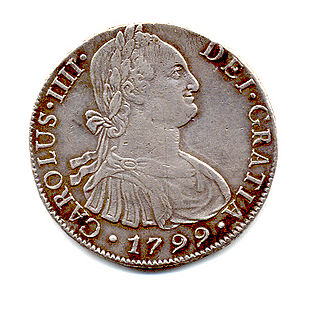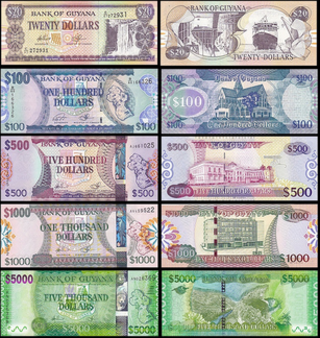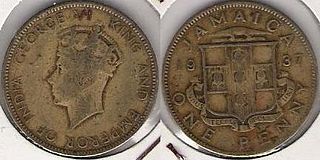The history of currency in the British colony of Grenada closely follows that of the British Eastern Caribbean territories in general. Even though Queen Anne's proclamation of 1704 brought the gold standard to the West Indies, silver pieces of eight (Spanish dollars and later Mexican dollars) continued to form a major portion of the circulating currency right into the latter half of the nineteenth century.

Grenada is a sovereign state in the West Indies in the Caribbean Sea at the southern end of the Grenadines island chain. Grenada consists of the island of Grenada itself plus six smaller islands which lie to the north of the main island. It is located northwest of Trinidad and Tobago, northeast of Venezuela and southwest of Saint Vincent and the Grenadines. Its size is 348.5 square kilometres (134.6 sq mi), and it had an estimated population of 112,200 in July 2018. Its capital is St. George's. Grenada is also known as the "Island of Spice" due to its production of nutmeg and mace crops, of which it is one of the world's largest exporters. The national bird of Grenada is the critically endangered Grenada dove.
Contents
Britain adopted the gold standard in 1821 and an imperial order-in-council of 1838 resulted in Grenada formally adopting the sterling currency in the year 1840. However, despite the circulation of British coins in Grenada, the silver pieces of eight continued to circulate alongside them and the private sector continued to use dollar accounts for reckoning. The international silver crisis of 1873 signalled the end of the silver dollar era in the West Indies and silver dollars were demonetized in Grenada in 1878. This left a state of affairs, in which the British coinage circulated, being reckoned in dollar accounts at an automatic conversion rate of 1 dollar = 4 shillings 2 pence.

The pound sterling, commonly known as the pound and less commonly referred to as sterling, is the official currency of the United Kingdom, Jersey, Guernsey, the Isle of Man, South Georgia and the South Sandwich Islands, the British Antarctic Territory, and Tristan da Cunha. It is subdivided into 100 pence. A number of nations that do not use sterling also have currencies called the pound.

The shilling is a unit of currency formerly used in Austria, the United Kingdom, Australia, New Zealand, United States and other British Commonwealth countries. Currently the shilling is used as a currency in four east African countries: Kenya, Tanzania, Uganda and Somalia. It is also the proposed currency that the east African community plans to introduce . The word shilling comes from old English "Scilling", a monetary term meaning twentieth of a pound, and from the Proto-Germanic root skiljaną meaning 'to separate, split, divide.' The word "Scilling" is mentioned in the earliest recorded Germanic law codes, those of Æthelberht of Kent.
From 1949, with the introduction of the British West Indies dollar, the currency of Grenada became officially tied up with that of the British Eastern Caribbean territories in general. The British sterling coinage was eventually replaced by a new decimal coinage in 1955, with the new cent being equal to one half of the old penny.
The British West Indies dollar (BWI$) was the currency of British Guiana and the Eastern Caribbean territories of the British West Indies from 1949 to 1965, when it was largely replaced by the East Caribbean dollar, and was one of the currencies used in Jamaica from 1954 to 1964. The monetary policy of the currency was overseen by the British Caribbean Currency Board (BCCB). The British West Indies dollar was never used in British Honduras, the Cayman Islands, the Turks and Caicos Islands, the Bahamas, or Bermuda.











